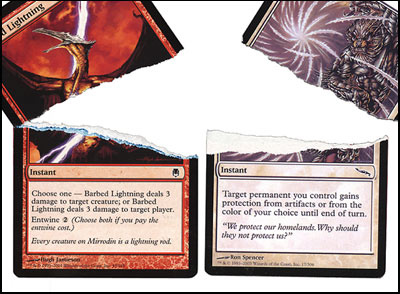By Cliff Daigle
For much of the MTG finance world, condition is a big deal. Scales, grading, and the smallest of dents can knock significant value off of a card.
However, to someone who is building a cube, or needs that last foil, or mainly plays at someone’s table on Saturdays… condition isn’t nearly as big a deal.
I tell you this because if you’ve ever tried to sell/trade to a vendor or a collector, you know that they will take money off based on their grade of the card. It can be frustrating and then some, especially if you think you’ve taken good care of it.
Here is a secret for dealing with most casual players: minor and sometimes major flaws in a card are not that important. I myself have a Bloodstained Mire that I bought for $15 from a retailer, because it had been bent. Undamaged ones were $30, and I had planned to get one of those, but when I put the bent card in a sleeve, the damage wasn’t easily apparent.
Should I ever need to trade that Mire, I’ll be looking for someone who doesn’t care about condition, and I’ll find such a person before too long.
Keep in mind that for older cards, condition is likely to be a key factor. Dual lands, pieces of Power, Alpha lands: all of these (and more) have their price affected by condition, sometimes heavily. These are 20-year-old pieces of cardboard, and very few have made it through unscathed. In case you didn’t know, we didn’t really have sleeves for cards for the first few years, and so the backs of cards will often have all sorts of dents and scratches from being turned sideways on a piece of concrete.
Now, it’s true that some cards are truly damaged and unplayable. Some are so warped that they cannot be used in tournaments, and I respect anyone who won’t keep such cards. But for many players, if it looks okay-to-decent in a sleeve, there’s no problem. You won’t get as much in trade as you would an undamaged card, but you’ll get more than you expect. In some cases, people won’t ask for less at all.
If they do care about the condition, and want to knock a little off the value, you should probably accept that it is indeed worth less (but not worthless!). If they want to grade the card in front of you, then it’s probably time to move on.
This is especially true with foils. I’ve met players who really wanted the effect a foil gets if it’s been played without a sleeve and there’s an edge of silver around the card, from where the black ink on the border has worn off. I’ve met others who don’t want that effect at all, and wanted a lot less than the card was worth.
When you’re trading online, then you’re in a much trickier area. I’ve had multiple experiences where cards arrived in a different condition than I expected, and I’ve had people say I sent Slightly Played cards instead of the Near Mint I promised them. My advice in this regard is to be open and honest. Communication is everything. If there’s a chance of a problem, scans are good, pictures are good.
On eBay, I’ve heard tales of someone who sold a card at NM price, but the buyer then claimed that the card was SP. So the buyer sent the card back, and indeed, it was a SP that got sent back. This is an evil, criminal tactic to upgrade the condition of a card and a reason why you need to be diligent with feedback. I’m told eBay always takes the buyer’s side, so be appropriately cautious.
Be cautious as well when you’re dealing with signed cards. Most vendors view that as a negative, even though many casual players will view a signed card as more unique and personalized. I like my signed cards, as they represent a journey of different artists I have met and events I have been to.
So if you have a slightly worn yet very awesome card, don’t despair. Just be patient. A vendor may not give you full value for it, but there are many trade partners who are looking for that exact card. You’ll find them, make the trade, and everyone wins.

I ordered a playset of “NM” Flagstones of Trokair from a fairly-reputable online dealer… when they showed up, they had all been signed by Rob Alexander.
I’m a total sig/alter whore, so it didn’t bother me, but it is something that is hard for retailers to show in a listing, since there isn’t a “signed” checkbox usually and taking individual photos is not realistic.
Thoughts?
That website took a big risk. Most collectors consider signed cards as either Heavily Played or Damaged :/